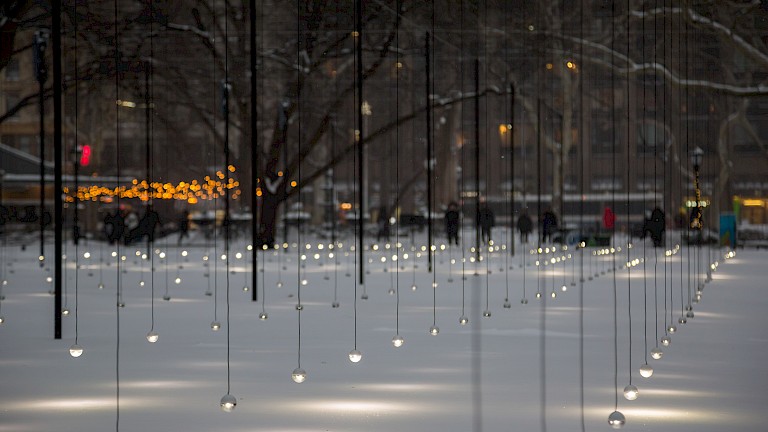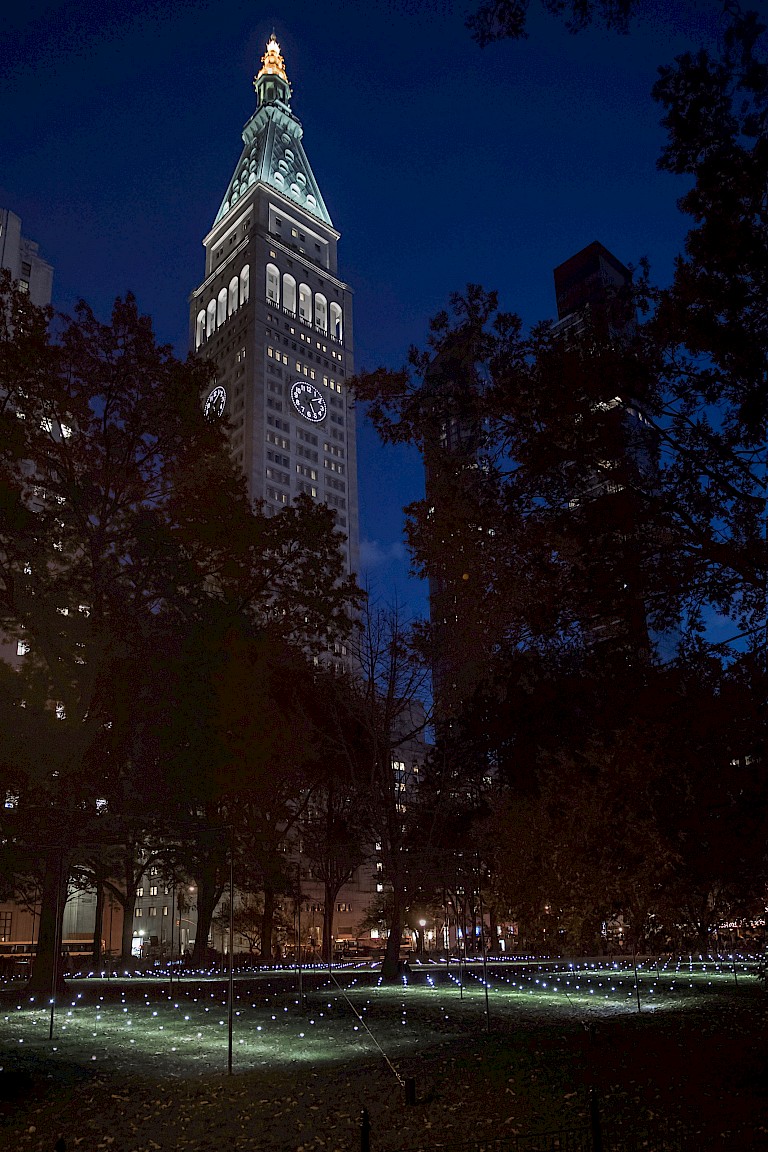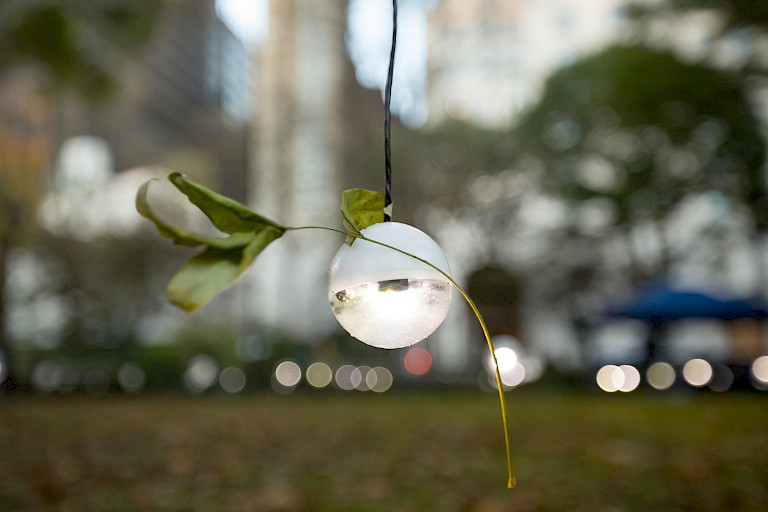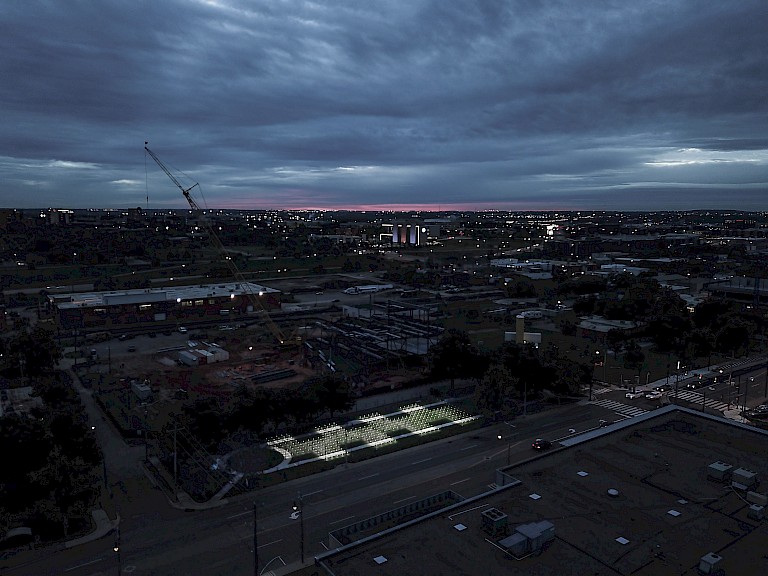



PROJECT DEVELOPMENT
Redl began discussing a commission with Madison Square Park Conservancy in 2014. A timeframe was set, and he launched into exploring different locations and possibilities. Planning continued despite challenges from engineers, however, high price estimates from installers sparked the need to dramatically overhaul his plans in February 2017, the year his project was set to premiere.
Although this presented a significant challenge, Redl noted that the shift in course resulted in his developing a “more humble” and virtual project that nevertheless had greater impact with less hardware. The space chosen, a large oval lawn within the park, was closed to the public over winter to allow the grass to recover from the busiest seasons. He therefore had a large open space to work within.
Redl brought in the public art consultancy, design studio, and workshop UAP, whose engineers collaborated on finalizing the design and whose workshop manufactured the steel posts that anchored the project’s grid. His own design studio developed the electronics and installed the piece to follow the elevation curve of the rolling lawn, with the assistance of added crew based in New York.
The project opened with a live performance of Craig Shepard’s “Trumpet Clouds,” performed by a dozen musicians moving among the installation’s lights. Subsequent programs included artist-led tours, panels, and artist talks with students from the School of Visual Arts.
Following its extended installation in New York, the Oklahoma Contemporary Arts Center brought Whiteout to Oklahoma City from October 11, 2018-March 31, 2019, with support from the Oklahoma City Community Foundation. The work’s modular design enabled Redl to develop a complex layout, along with tailored lighting sequences to suit the project’s new home. Redl and his team, working with local contractors, installed 550 orbs across the manicured lawn of Campbell Art Park, adjacent to the museum.
ARTWORK EXCELLENCE
Redl’s artistic influences range from training in furniture making to electronic music composition, and minimal and conceptual art. Early on in his artistic trajectory, as he began transferring his musical computer programming training to visual art projects, he found himself frustrated by the flatness of the computer screen, wanting to enter the abstract, virtual world as a body. Today, with space as his medium, he describes his approach as applying the analytically trained mind of computer programming to the physical world. This approach has led Redl to create spaces pervaded with meticulously positioned points of light in his Matrix series, projection pieces filling the windows of vacant buildings, and architecturally embedded light projects, to name a few.
The human body is central to this configuration. Redl emphasizes this point by stating that he likes work that “smells”—work that engages the senses and incorporates the audience as peripatetic and fully embodied. In the context of Whiteout, the very act of being drawn toward light in the darkness goes beyond the visual. It is a physical experience of the body moving through space. While grounded in the senses, Redl also speaks of his work in relation to the virtual, where the audience can leave their baggage behind and enter like an avatar to explore a new world.
While Whiteout was a light-based work, it was also more than an encounter with light. It was in part rooted in the spaces in-between the lights and the rhythm of darkness and light together. Referencing his background in music, Redl noted the importance of time in the experience of the work, likening his programming to conducting. Centering the intersection of abstraction and corporeality, he spoke of his work in relation to the question, “How does this rhythm feel on my body?” (Silvis, 2021). In doing so, he linked abstract patterns with the embodied experience of the artwork, a holistic encounter that spans the time and rhythm of the light sequences.
Simultaneously, in its New York installation, Whiteout could be seen from surrounding buildings, existing at multiple layers from the immediate to the distant. Brooke Kamin Rapaport, director and senior curator of Madison Square Art, noted in the project’s catalogue:
“From the ground plane, visitors feel how their body moves in space to perceive or view light, how people are physically drawn to light, how the work is a beacon across space. From the aerial view, the movement of the public is in dialogue with the orbs, swaying opportunistically and through kinetic force with the wind and with the virtual movement of the LEDs.”
Redl intentionally hid the technology behind the project, allowing the intricately planned and produced artwork to flow seemingly effortlessly through time and space. At the same time, he noted that the project offered a chance to consider and blur assumed divisions between natural and digital worlds. Here, the highly technological project was subject to the whims of a breeze and surrounded by an environment changing daily and through the seasons. Audiences may have been drawn by the light but they were also pulled into the virtual space that Redl sought to reach into when he first explored how to circumvent the flatness of a computer screen.
In its many layers of abstraction, corporeality, time and rhythm, advanced technologies, and its relationship with its environment, Whiteout offered a rich conceptual and physical ground for its audiences to explore.
CONTEXT & ANALYSIS
Redl has described a pivotal point in his artistic journey, a visit to Dia in 1997 where he saw Fred Sandback’s yarn installations that created complex volumes, divisions, geometric patterns, and dynamic relationships all with the simple tool of strung yarn. This use of minimal material for maximal effect would inform Redl’s own nexus of abstraction and corporeality.
Staking his work within the traditions of conceptualism and minimalism, he frames his effort to move beyond emotional gravity as a method of releasing inhibitions. Acknowledging the influence of Sol LeWitt, he commented, “I see those wall drawings and my body starts vibrating.” He therefore situates his work as a visceral encounter with minimalist abstraction. In contrast, his usage of digital technologies can result in institutions or audiences labeling his work based on the tools he uses. However, he notes the significant distinction between his minimalist aesthetic and pockets of the arts and technology arena that foreground a “techno-aesthetic” or the DIY centering of gear and hardware (Daley, 2021).
Redl further differentiates his approach from a techno ambiance in describing his artistic development as less informed by the hard and fast edges of technology-oriented spaces and “more influenced by very long processes that you see in nature” (Daley, 2021). In this vein, he acknowledges the influence of artists engaging in the long timespan of shifting light in space, in particular James Turrell. Curator Brooke Kamin Rapaport further underscored this aspect of Redl’s work in Whiteout, commenting that “Erwin is becoming a reinterpreter of Land Art and earthworks in this project” (Sheets, 2017).
In addition to minimalism, conceptualism, and the extension of time, Redl’s work is characterized by his approach—a cerebral, analytical orientation that, through painstaking labor, is manifested in a manner that centers the corporeal. He describes this tactic as a mixing of the left and right brain, a melding of creativity and meticulous attention to detail.
Through these many references and associations, Redl’s work both stand within influential currents of 20th/21st century artistic practice while also standing on its own. In blending abstraction and minimalism with the full senses of the body and the possibilities opened up by public space, he invites audiences to enter into another world, to immerse themselves in the experience of being with the work and to emerge with their own stories to tell.
**Unless otherwise noted, quotations above are drawn from an interview with the artist conducted by the project researcher on May 19, 2021.
SELECT REFERENCES
Daley, Chenée. “Artist Interview: Erwin Redl.” BRIC. January 4, 2021. Accessed May 10, 2021. https://www.bricartsmedia.org/blog/artist-interview-erwin-redl
Rapaport, Brooke Kamin. “Introduction.” Erwin Redl Whiteout. New York: Madison Square Park Conservancy, 2017. https://18p95aamd693k2glx3ytryxr-wpengine.netdna-ssl.com/wp-content/uploads/2021/03/Erwin-Redl_Whiteout.pdf
Redl, Erwin. “Artist’s Statement.” Erwin Redl Whiteout. New York: Madison Square Park Conservancy, 2017. https://18p95aamd693k2glx3ytryxr-wpengine.netdna-ssl.com/wp-content/uploads/2021/03/Erwin-Redl_Whiteout.pdf
Sheets, Hilarie. “A Light Touch in Madison Square Park: Erwin Redl Reinterprets Land Art in the Middle of Manhattan.” ARTnews. November 28, 2017. Accessed May 10, 2021. https://www.artnews.com/art-news/artists/light-touch-madison-square-park-erwin-redl-reinterprets-land-art-middle-manhattan-9387/
Silvis, John. “Erwin Redl” (Interview). Six Degrees of Silvis. Podcast, 31:08. May 1, 2021. Accessed May 29, 2021. https://www.johnsilvis.com/six-degrees-of-silvis-podcast



